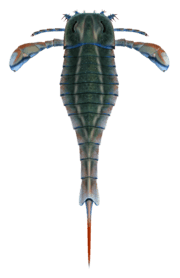Wiedopterus
| Wiedopterus | |
|---|---|
| Scientific classification | |
| Kingdom: | Animalia |
| Phylum: | Arthropoda |
| Subphylum: | Chelicerata |
| Order: | †Eurypterida |
| Suborder: | †Eurypterina |
| Genus: | †Wiedopterus Poschmann, 2015 |
| Type species | |
| †Wiedopterus noctua Poschmann, 2015 | |
Wiedopterus is a genus of prehistoric eurypterid. The genus contains one species, W. noctua, recovered from deposits of Early Devonian age in the Lahrbach Valley, Germany.[1] The generic name derives from the Wied river, which runs near the site of the initial discovery, and the species name, noctua, derives from Latin noctua (owl) which refers to the superficial resemblance of the carapace and eyes to an owl.[1]
Description
Wiedopterus was a eurypterid of medium size, the holotype and only known specimen preserving somewhere around half the animal and measuring about 40 mm in length,[1] that can be differentiated from other eurypterids by several distinct features. These features include its trapezoid carapace with a narrow marginal rim, lateral eyes in a position close to the center of the carapace, a rounded and wide preabdomen with reduced tergites anteriorly, the tergites possessing narrow anterior articulation facets, a marked constriction between the preabdomen and the postabdomen and that the dorsal preabdomen lacks any prominent ornaments.[1]
References
- 1 2 3 4 Poschmann, Markus (2015-12-01). "Sea scorpions (Chelicerata, Eurypterida) from the Lower Devonian (Siegenian) of the Lahrbach Valley/Westerwald area (SW Germany, Rhineland-Palatinate)". Paläontologische Zeitschrift. 89 (4): 783–793. doi:10.1007/s12542-015-0261-9. ISSN 0031-0220.
See also
